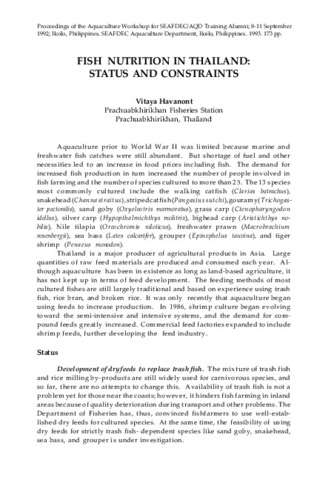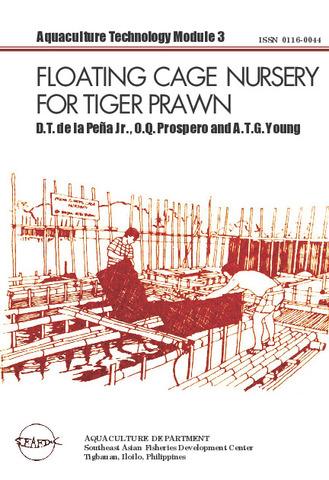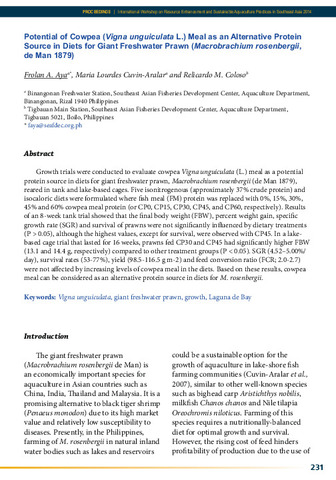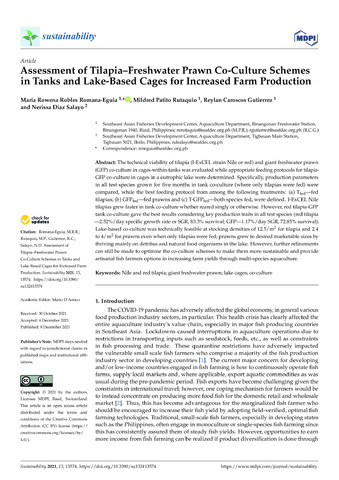Fish nutrition in Thailand: Status and constraints
Share
Abstract
Aquaculture prior to World War II was limited because marine and freshwater fish catches were still abundant. But shortage of fuel and other necessities led to an increase in food prices including fish. The demand for increased fish production in turn increased the number of people involved in fish farming and the number of species cultured to more than 25. The 13 species most commonly cultured include the walking catfish (Clarias batrachus), snakehead (Channa straitus),striped catfish (Pangasius sutchi), gouramy (Trichogaster pectoralis), sand goby (Oxyeleotris marmoratus), grass carp (Ctenopharyngodon idellus), silver carp (Hypopthalmichthys molitrix), bighead carp (Aristichthys nobilis), Nile tilapia (Oreochromis niloticus), freshwater prawn (Macrobrachium rosenbergii), sea bass (Lates calcarifer), grouper (Epinephelus tauvina), and tiger shrimp (Penaeus monodon). Thailand is a major producer of agricultural products in Asia. Large quantities of raw feed materials are produced and consumed each year. Although aquaculture has been in existence as long as land-based agriculture, it has not kept up in terms of feed development. The feeding methods of most cultured fishes are still largely traditional and based on experience using trash fish, rice bran, and broken rice. It was only recently that aquaculture began using feeds to increase production. In 1986, shrimp culture began evolving toward the semi-intensive and intensive systems, and the demand for compound feeds greatly increased. Commercial feed factories expanded to include shrimp feeds, further developing the feed industry.
Suggested Citation
Havanont, V. (1993). Fish nutrition in Thailand: Status and constraints. In C. T. Villegas, M. T. Castaños, & R. B. Lacierda (Eds.), Proceedings of the Aquaculture Workshop for SEAFDEC/AQD Training Alumni, 8-11 September 1992, Iloilo, Philippines (pp. 74-79). Tigbauan, Iloilo, Philippines: Aquaculture Department, Southeast Asian Fisheries Development Center.
Subject
animal nutrition  ; shrimp culture
; shrimp culture  ; feeds
; feeds  ; prawn culture
; prawn culture  ; cultured organisms; aquaculture
; cultured organisms; aquaculture  ; fish culture
; fish culture  ; aquaculture systems
; aquaculture systems  ; Ctenopharyngodon idella
; Ctenopharyngodon idella  ; Penaeus monodon
; Penaeus monodon  ; Clarias batrachus
; Clarias batrachus  ; Trichogaster pectoralis
; Trichogaster pectoralis  ; Hypophthalmichthys molitrix
; Hypophthalmichthys molitrix  ; Lates calcarifer
; Lates calcarifer  ; Channa striatus
; Channa striatus  ; Epinephelus tauvina
; Epinephelus tauvina  ; Macrobrachium rosenbergii
; Macrobrachium rosenbergii  ; Oreochromis niloticus
; Oreochromis niloticus  ; Thailand
; Thailand  ; Chevron snakehead; Giant perch; Giant river prawn; Giant tiger prawn; grass carp
; Chevron snakehead; Giant perch; Giant river prawn; Giant tiger prawn; grass carp  ; silver carp
; silver carp  ; Snake-skinned gourami; Striped snakehead; Walking catfish
; Snake-skinned gourami; Striped snakehead; Walking catfish
 ; shrimp culture
; shrimp culture  ; feeds
; feeds  ; prawn culture
; prawn culture  ; cultured organisms; aquaculture
; cultured organisms; aquaculture  ; fish culture
; fish culture  ; aquaculture systems
; aquaculture systems  ; Ctenopharyngodon idella
; Ctenopharyngodon idella  ; Penaeus monodon
; Penaeus monodon  ; Clarias batrachus
; Clarias batrachus  ; Trichogaster pectoralis
; Trichogaster pectoralis  ; Hypophthalmichthys molitrix
; Hypophthalmichthys molitrix  ; Lates calcarifer
; Lates calcarifer  ; Channa striatus
; Channa striatus  ; Epinephelus tauvina
; Epinephelus tauvina  ; Macrobrachium rosenbergii
; Macrobrachium rosenbergii  ; Oreochromis niloticus
; Oreochromis niloticus  ; Thailand
; Thailand  ; Chevron snakehead; Giant perch; Giant river prawn; Giant tiger prawn; grass carp
; Chevron snakehead; Giant perch; Giant river prawn; Giant tiger prawn; grass carp  ; silver carp
; silver carp  ; Snake-skinned gourami; Striped snakehead; Walking catfish
; Snake-skinned gourami; Striped snakehead; Walking catfish
Taxonomic term
Related items
Showing items related by title, author, creator and subject.
-
Floating cage nursery for tiger prawn
de la Peña, Dioscoro T.; Prospero, Oscar Q.; Young, Alexander Thomas G. (Aquaculture Department, Southeast Asian Fisheries Development Center, 1985) -
Potential of cowpea (Vigna unguiculata L.) meal as an alternative protein source in diets for giant freshwater prawn (Macrobrachium rosenbergii, de Man 1879)
Aya, Frolan; Cuvin-Aralar, Maria Lourdes; Coloso, Relicardo M. (Aquaculture Department, Southeast Asian Fisheries Development Center, 2015)Growth trials were conducted to evaluate cowpea Vigna unguiculata (L.) meal as a potential protein source in diets for giant freshwater prawn, Macrobrachium rosenbergii (de Man 1879), reared in tank and lake-based cages. ... -
Assessment of tilapia-freshwater prawn co-culture schemes in tanks and lake-based cages for increased farm production
Romana-Eguia, Maria Rowena R.; Rutaquio, Mildred P.; Gutierrez, Reylan C.; Salayo, Nerissa D. (MDPI, 2021-12-08)The technical viability of tilapia (I-ExCEL strain Nile or red) and giant freshwater prawn (GFP) co-culture in cages-within-tanks was evaluated while appropriate feeding protocols for tilapia-GFP co-culture in cages in a ...





